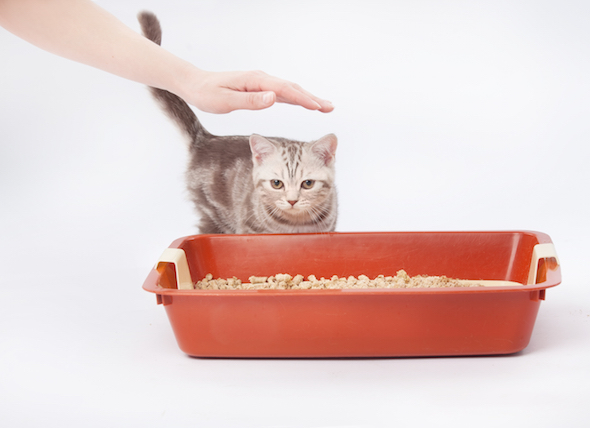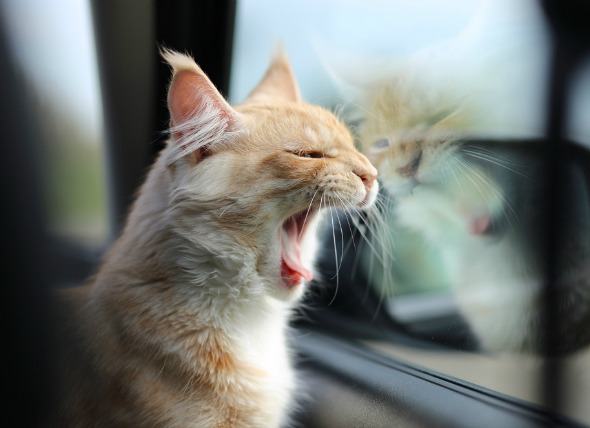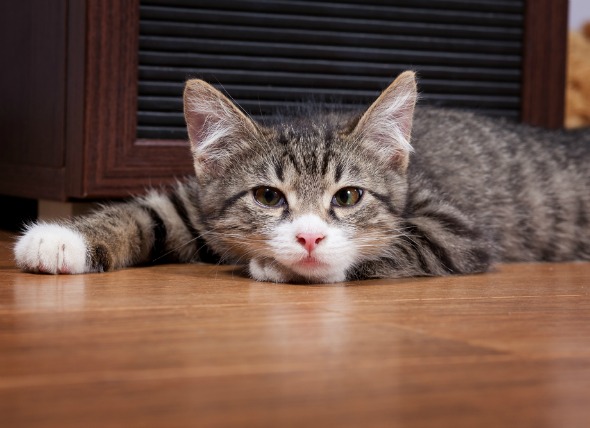

By Michelle Shapiro
When your cat takes to urinating outside the litter box, the smell can be difficult to get rid of and nearly impossible to mask. Whether the cat pees on a carpet, a piece of furniture, bed linens, or your clothes, it’s important to neutralize the odor both to avoid embarrassment and to prevent the cat from becoming a repeat offender, as they’ll often return to a spot where they have previously urinated if the odor is not eliminated. Consider this your ultimate guide to eliminating cat urine smells from your home and determining why your cat may be urinating outside of his or her litter box.
Cat urine is not all that different from other animals’ urine, but what gives cat urine such a bad smell is that the urine is usually left unnoticed until it becomes a problem. Cats have a propensity to mark their territory outside the litter box, be it on the carpet or in hidden corners. After a while, the bacterium in the urine decomposes and gives off an ammonia-like odor characteristic of stale old urine. The second stage of the decomposition process emits mercaptans, compounds that give skunk spray its characteristic bad smell. Older animals have kidneys that have lost some of their efficiency and, as a consequence, older animals tend to have the worst smelling urine.
Adding to the stench are the powerful hormones that cats eliminate when they pee. Unless male cats are neutered, their testosterone-spiked urine signals other males to stay away and lets females know they’re around.
There are a number of reasons as to why your cat may have started turning up his or her tail at the place he or she is supposed to pee. Owners often think cats urinate in inappropriate places as a way of getting even, but they lack the sophisticated cognitive abilities needed to concoct a revenge strategy.
“Despite popular belief, cats do not urinate outside the box to 'get back' at the owner for something,” said Laura George, DVM at Cats Exclusive Veterinary Center in Shoreline, Washington.
If your cat’s not using the litter box, it’s likely that he or she is trying to tell you something. The first thing you need to do is rule out a medical problem, said Bruce Kornreich, DVM, PhD, DACVIM and associate director of the Cornell Feline Health Center. Medical issues related to inappropriate urination can include urinary tract infections, kidney disease, diabetes, hyperthyroidism and feline lower urinary tract disease, and can cause a cat to urinate outside the litter box, particularly if he or she associates the litter box with pain. If you believe your cat is suffering from any of these conditions, or is exhibiting additional symptoms, bring them to your veterinarian immediately, as untreated conditions, like urinary tract infections, can become serious.
Another possible reason that an older cat may forego the litter box is arthritis. “As cats age, they can get arthritis, which makes it harder for them to get into the box,” Kornreich said. “Perhaps the sides are too tall or the box is located in a place that requires the cat to do some kind of arduous physical activity to get to, such as up or down a flight of stairs.”
Once you’ve ruled out any illness, determine if there’s a behavioral reason that your cat isn’t going in his usual spot. “You need to be a detective and take the time to figure out why the cat’s behavior has changed,” said Sandra DeFeo, executive director of the Humane Society of New York. According to DeFeo, not using the litter box is one of the most common reasons cats are relinquished to animal shelters. Fortunately, if you can pinpoint the reason behind the cat’s outside-the-litter box behavior, you can often deter your cat from staining your carpet or bed linens.
“If there is not a medical problem and the problem truly is behavioral, early intervention is key,” George said. “Behavioral issues can sometimes be resolved by adding additional litter boxes around the home, scooping frequently to remove waste or by moving a litter box from one space in the home to another.”
As a general rule, you should keep as many litter boxes as you have cats in the house, plus one. You can also try removing the cover of your cat’s litter box (if it has one) or changing the type of litter you use to encourage your cat to use his or her box.
While some cats squat and urinate on bare floors, carpet, furniture and other horizontal surfaces, others will spray urine on vertical surfaces around the home. “Unfixed males spray to mark their territory, and unfixed females spray to let tomcats know they are ready [to mate]” DeFeo said. To avoid such behaviors, she suggests getting male cats neutered and female cats spayed at six months.
Although cats are often driven to spray by hormones, there are other reasons for it. Cats may spray out of stress, anxiety, or frustration with their circumstances, including such conditions as restrictive diets, insufficient playtime or territorial disputes with other cats. If your cat is spraying because of disputes with either other cats in the home or in the neighborhood, it’s important for you to identify and remove the stimuli. Separate feuding cats in your household and reintroduce them slowly, using food treats to reward and encourage peaceful behavior. To ease anxiety, try a plug-in diffuser that releases a synthetic cat pheromone developed to reassure your cat.
If your cat is spraying out of stress or anxiety, discuss these issues with your veterinarian and work with them to develop a solution to minimize your cat’s stress.
As bad as cat pee smells the moment after your cat urinates or sprays, the longer that urine sits, the worse the stench becomes. “The smell gets more concentrated over time,” Kornreich said.
Additionally, once a urine stain dries, you may no longer see it but you can still smell it, and so can your cat, leading him or her to re-mark the area. “When it comes to cleaning up cat urine, many cat owners make the same mistake—not cleaning it up quickly enough,” says Meg Roberts, president of Molly Maid, a residential cleaning company.
Fortunately, there are several ways to neutralize the odor, including pantry staples like vinegar or baking soda and enzymatic cleaners. Many find that vinegar, while a bit smelly itself, works to remove the lasting odor of sprayed cat urine because vinegar is an acid that neutralizes the alkaline salts that form in dried urine stains. A solution of one part water and one part vinegar can be used to clean walls and floors. Proponents say that the vinegar smell subsides after a few days, taking the urine smell with it.
Others believe the most powerful weapon in the fight against odor elimination in carpets, couch cushions, mattresses and linens is an enzyme-based cleaner that can be found at local pet stores. The enzymes in these products actually break down the acid in cat urine, helping to get rid of the smell at the same time. These cleaners contain natural enzymes and helpful bacteria to get rid of the bad bacteria causing the unpleasant odors.
When cleaning any surface, it’s important to get to the point not only where you cannot smell the urine, but your cat can’t smell it either. “When a cat can smell a previous urine spot (from themselves or another cat), that area is likely to be used again,” George said.
Most importantly, you’ll want to avoid any cleaning products that contain ammonia. “Ammonia is one component of cat urine, and if cats smell that they’re more likely to go there,” Kornreich said. In addition, ammonia and other chemical cleaners can often set the stain—the opposite of what you’re trying to do.
You’ll want to find the stain as soon as possible and blot up as much of the urine as you can with a clean cloth. Next, rinse the area with clean water and remove the liquid with a wet/dry vacuum. “You don’t want to use a steam cleaner, as the heat can set the stain,” Roberts said. Follow with an enzyme cleaner.
While enzyme cleaners come in a spray bottle, spraying a light coat over the stain won’t do much. Instead, remove the sprayer and douse the spot liberally. Let the cleaner sit for 10 to 15 minutes and blot up as much of it as possible with a clean cloth. To keep the cat from returning to the spot during the cleaning process, place a piece of aluminum foil or an aluminum baking sheet over the area, or cover it with an upside-down laundry basket. You may need to reapply the cleaner to the area and let it dry again for older or particularly odorous stains.
Urine can often soak through the carpet and into the subflooring, leaving a stain and a stench that can’t be lifted with carpet cleaner and elbow grease. If you have pet odor that will not go away despite your best carpet-cleaning efforts, neutralize the scent by using an oil-based, stain-blocking primer beneath the carpeting on the subfloor and replace the padding as well as that area of carpet.
Once you’ve cleaned a particular area, prevent a recurrence by changing the significance of that area to your cat. In other words, since cats prefer to eat and eliminate in separate areas, place food bowls and treats in previously soiled areas, or play with your cat in that space and leave toys there.
Cushions and mattresses can be cleaned in a fashion similar to carpets. Soak the affected area of the cushion with water. Blot up as much of the cat urine as possible with a towel, then soak the cushion by very slowly pouring the enzyme cleaner on and around the affected area. Let it sit for 15 minutes, then squish out as much of the excess enzyme cleaner as possible before blotting with towels. If possible, leave the cushion outside as long as possible while it dries. Since cushions take days to dry, lay aluminum foil down before putting the cushion back, then put a second layer of foil over the top of the cushion to discourage your cat from peeing on the cushion again.
Mattresses require the same process as cushion. After applying the enzymatic cleaner, letting it sit and blotting it up, place several layers of clean towels over the area and then make the bed. Swap out the towels each day until the mattress completely dries. To discourage peeing on the spot while the mattress dries, cover the bed with a large plastic sheet or tarp when you’re not using it. DeFeo also suggests keeping a plastic cover over your mattress at all times, particularly if your cat has taken to peeing outside its litter box.
Thick cushions and mattresses may require several applications to completely remove the cat urine.
If your bed linens and clothing items are machine washable, first rinse the spot in a sink with cool water, then add them to the washing machine with detergent and a cup of baking soda or a quarter cup of cider vinegar. If you can still smell the urine after the cycle is complete, add enzyme cleaner to the load (following instructions on the package) and run the cycle again. Remember never to use bleach (when mixed with ammonia and cat urine, it can cause harmful gases). Always air dry linens, as the heat of the dryer may lock in the smell before it’s completely gone. You may need to re-wash one or more times until the scent is completely gone.
 Catittude: Why is My Cat so Mean?
By Helen Anne Travis
Has Kitty b
Catittude: Why is My Cat so Mean?
By Helen Anne Travis
Has Kitty b
 Importance of Antioxidants in Pet Food
By Jennifer Coates, DVM
Antioxi
Importance of Antioxidants in Pet Food
By Jennifer Coates, DVM
Antioxi
 How Gene Research Can Help Your Cat Lose Weight
By Jennifer Coates, DVM
It's easy
How Gene Research Can Help Your Cat Lose Weight
By Jennifer Coates, DVM
It's easy
 On the Road with Kitty
The very first rule of traveling with your cat is to have
On the Road with Kitty
The very first rule of traveling with your cat is to have
 What's Wrong with My Cat?
Does My Cat Have a Behavior Issue
What's Wrong with My Cat?
Does My Cat Have a Behavior Issue
Copyright © 2005-2016 Pet Information All Rights Reserved
Contact us: www162date@outlook.com